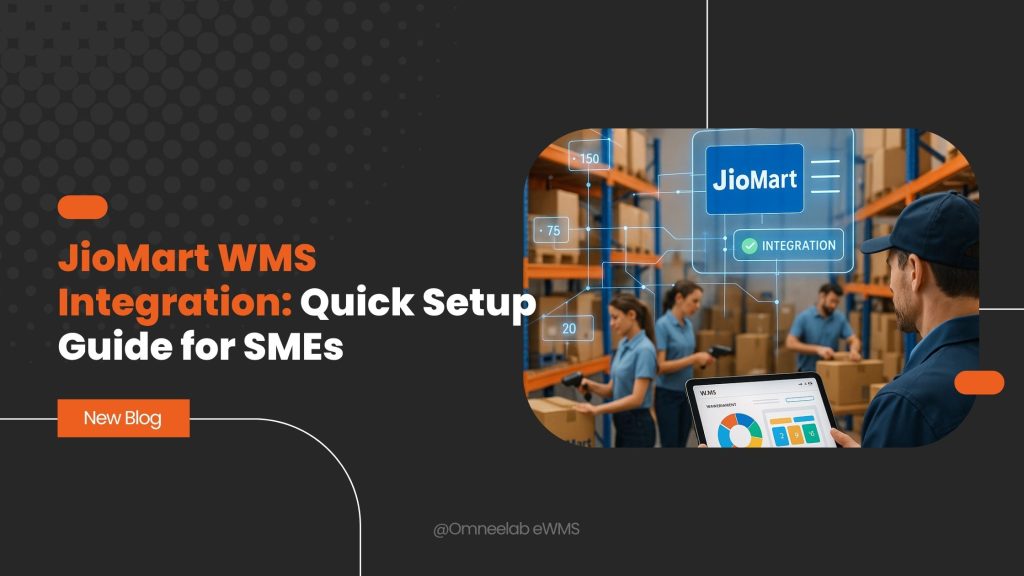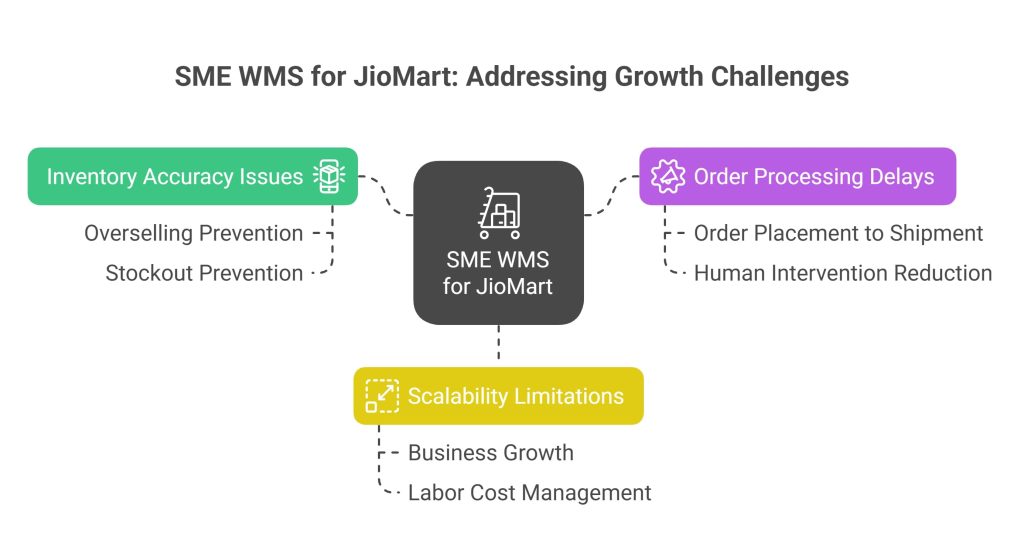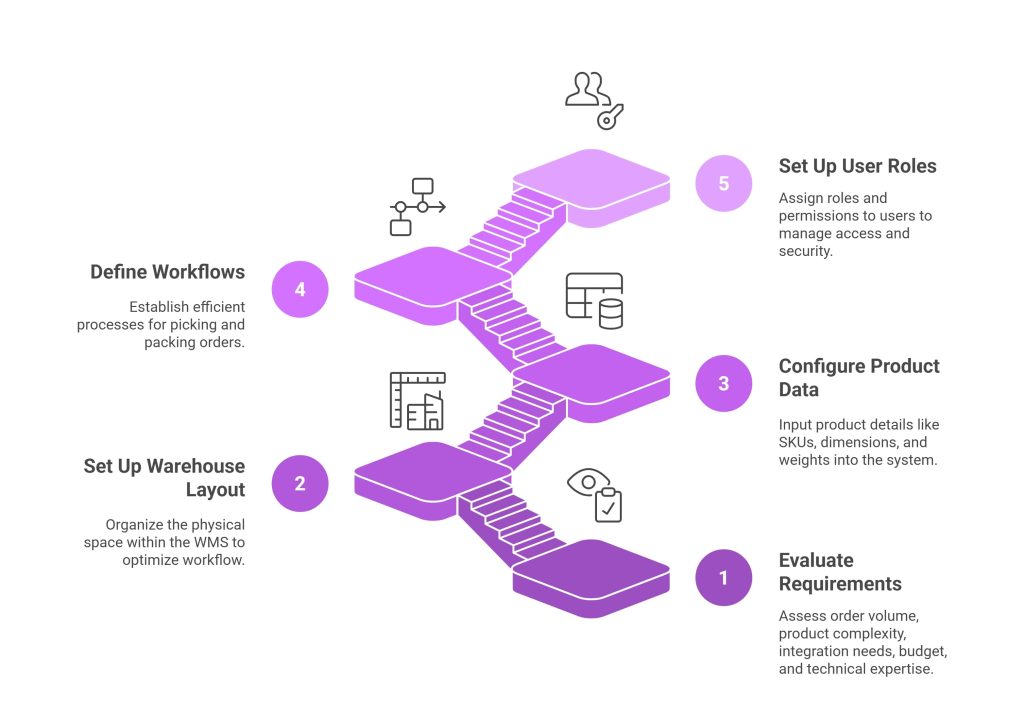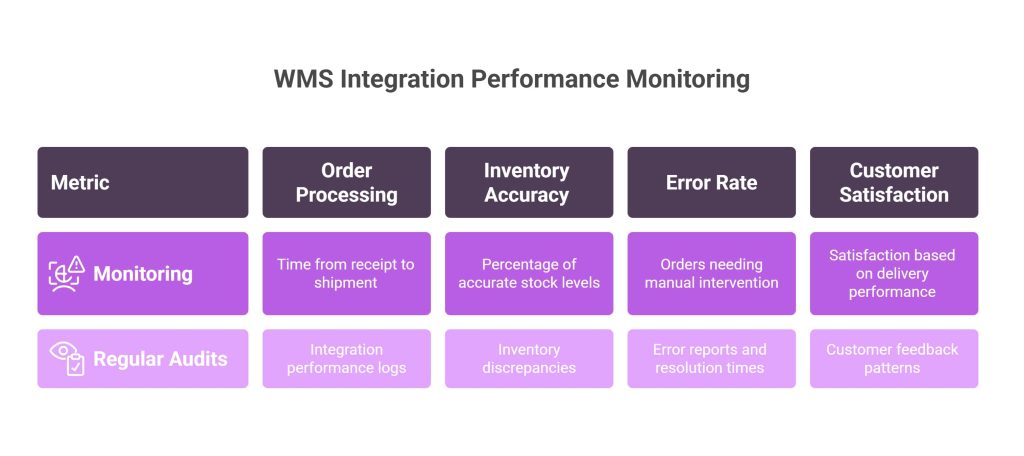Running a small or medium enterprise (SME) on JioMart can feel like juggling flaming torches while riding a unicycle. You’ve got orders pouring in, inventory to track, and customers expecting lightning-fast delivery. Sound familiar?

If you’re nodding your head, then JioMart WMS integration might just be the game-changer your business needs. Think of a Warehouse Management System (WMS) as your digital warehouse assistant – one that never sleeps, never makes mistakes, and can handle thousands of orders without breaking a sweat.
In this comprehensive guide, we’ll walk you through everything you need to know about setting up WMS integration JioMart for your SME. From choosing the right provider to configuring your system, we’ve got you covered. By the end of this article, you’ll have a clear roadmap to streamline your operations and scale your business efficiently.
What is JioMart WMS Integration?
Before diving into the setup process, let’s clarify what we’re talking about. JioMart WMS integration is the process of connecting your warehouse management system with JioMart’s platform to automate order processing, inventory management, and fulfillment operations.
Imagine your WMS as the brain of your warehouse operations, while JioMart acts as your storefront. When these two systems talk to each other seamlessly, magic happens:
- Orders automatically flow from JioMart to your WMS
- JioMart inventory sync happens in real-time
- Shipping labels generate automatically
- Customer notifications are sent without manual intervention
For SMEs, this integration eliminates the tedious manual work that often leads to errors and delays. Instead of copying order details from JioMart to your warehouse system, everything happens automatically.
Why SMEs Need WMS for JioMart Operations
The Growing Complexity Challenge
As your JioMart business grows, managing operations manually becomes increasingly difficult. What worked when you had 10 orders per day won’t scale when you’re processing 100 or 1,000 orders daily.
SME WMS for JioMart addresses several critical pain points:
- Inventory Accuracy Issues Manual inventory tracking often leads to overselling or stockouts. A WMS provides real-time inventory visibility across all your sales channels, preventing these costly mistakes.
- Order Processing Delays Processing orders manually is time-consuming and error-prone. With JioMart order fulfillment automation, orders move from placement to shipment without human intervention.
- Scalability Limitations Manual processes don’t scale. As your business grows, you’d need to hire more staff just to handle basic operations. A WMS grows with your business without proportional increases in labor costs.

Competitive Advantages
SMEs using warehouse software JioMart integration often see significant improvements:
- Faster Order Processing: Orders ship 2-3x faster compared to manual processing
- Reduced Errors: Automation eliminates human errors in order picking and packing
- Better Customer Experience: Accurate tracking information and faster deliveries improve customer satisfaction
- Cost Savings: Reduced labor costs and fewer errors translate to better profit margins
Top WMS Providers for JioMart Integration
Choosing the right WMS provider is crucial for successful JioMart integration setup. Here are the leading options for SMEs:
Omneelab WMS JioMart Integration
Omneelab WMS emerges as a compelling choice for SMEs seeking advanced warehouse management capabilities. With over 15 years of collective team experience in the industry, Omneelab understands the versatility required while managing a warehouse Features:
- Intelligent automation that reduces manual intervention by up to 40%
- Multi-channel integration capabilities for unified inventory control
- Predictive maintenance features to prevent operational disruptions
- Customizable workflows adaptable to specific business requirements
- Real-time analytics dashboard for data-driven decision making
Unicommerce JioMart Integration
Unicommerce stands out as one of the most popular choices for Indian e-commerce businesses. Their Unicommerce JioMart integration offers:
Key Features:
- Native JioMart connectivity
- Multi-channel inventory management
- Automated order routing
- Real-time analytics dashboard
WareIQ JioMart Integration
WareIQ JioMart integration focuses on end-to-end fulfillment solutions:
Key Features:
- Pan-India fulfillment network
- Same-day and next-day delivery options
- Integrated warehouse management
- AI-powered demand forecasting
Ginesys JioMart OMS
Ginesys offers comprehensive retail management solutions with strong Ginesys JioMart OMS capabilities:
Key Features:
- Unified order management across channels
- Advanced inventory optimization
- Built-in accounting integration
- Customizable workflows
Step-by-Step JioMart WMS Setup Guide
Now, let’s dive into the practical aspects of JioMart WMS setup. This quick JioMart WMS guide will walk you through the essential steps:
Step 1: Prepare Your JioMart Account
Before integrating any WMS, ensure your JioMart seller account is properly configured:
Account Verification
- Complete all KYC requirements
- Verify your business documents
- Ensure your product catalog is updated
API Access Setup
- Request JioMart API credentials from your account manager
- Document your store ID and other essential identifiers
- Test API connectivity using provided documentation
Step 2: Choose and Configure Your WMS Provider
Evaluate Your Requirements Consider these factors when selecting your WMS for small businesses:
- Order volume (current and projected)
- Product categories and complexity
- Integration requirements with other systems
- Budget constraints
- Technical expertise available in-house

Initial Configuration Once you’ve chosen a provider:
- Set up your warehouse layout in the WMS
- Configure product master data with SKUs, dimensions, and weights
- Define picking and packing workflows
- Set up user roles and permissions
Step 3: Establish the Integration Connection
Technical Setup Most modern WMS providers offer plug-and-play JioMart warehouse management integration:
- Enter JioMart API credentials in your WMS dashboard
- Map product SKUs between JioMart and your WMS
- Configure order import settings (frequency, filters, etc.)
- Set up inventory sync parameters
Testing Phase Before going live, thoroughly test the integration:
- Process test orders end-to-end
- Verify inventory sync accuracy
- Test error handling scenarios
- Validate shipping label generation
Step 4: Configure Automation Rules
Order Routing Set up rules for automatic order processing:
- Priority-based routing (express vs. standard delivery)
- Location-based allocation for multi-warehouse operations
- Product-specific handling requirements
Inventory Management Configure automatic inventory updates:
- Real-time sync frequency (recommended: every 15 minutes)
- Safety stock levels to prevent stockouts
- Reorder point alerts for proactive purchasing
People also read: Free SOPs Guide for Inventory Management
Optimizing Your WMS Integration
Performance Monitoring
Key Metrics to Track Monitor these essential KPIs to ensure your JioMart order management system is performing optimally:
- Order Processing Time: From order receipt to shipment
- Inventory Accuracy: Percentage of accurate stock levels
- Error Rate: Orders requiring manual intervention
- Customer Satisfaction: Based on delivery performance

Regular Audits Conduct monthly reviews of:
- Integration performance logs
- Error reports and resolution times
- Inventory discrepancies
- Customer feedback patterns
Advanced Features Implementation
Demand Forecasting Leverage your WMS data for better planning:
- Analyze historical sales patterns
- Identify seasonal trends
- Optimize inventory levels based on predictions
For businesses seeking cutting-edge capabilities, Omneelab’s AI-powered warehouse management solutions can provide predictive analytics and intelligent inventory optimization Their system helps businesses improve inventory visibility, efficiency, and profitability through advanced automation Expansion** Once your JioMart integration is stable, consider expanding to other marketplaces:
- Amazon integration
- Flipkart connectivity
- Myntra Integration
- Meesho Integration
- Your own e-commerce website
Common Challenges and Solutions
Integration Hiccups
API Connectivity Issues Sometimes, the connection between your WMS and JioMart might face disruptions:
Solution: Implement robust error handling and retry mechanisms. Most quality WMS providers include automatic reconnection features.
Data Mapping Errors Mismatched product information between systems can cause order processing failures:
Solution: Maintain a comprehensive SKU mapping document and regularly audit data consistency.
Inventory Synchronization Problems
Overselling Scenarios When inventory updates lag, you might sell products that are out of stock:
Solution: Implement buffer stock levels and increase sync frequency during peak sales periods.
Multi-Location Complexity Managing inventory across multiple warehouses adds complexity:
Solution: Use location-based inventory allocation rules and maintain clear visibility across all locations.
Scaling Challenges
Performance Degradation As order volumes increase, system performance might suffer:
Solution: Regularly review and optimize your WMS configuration. Consider upgrading to higher-tier plans when necessary.
Staff Training Requirements New team members need proper training on the integrated system:
Solution: Develop comprehensive training materials and conduct regular refresher sessions.
Cost-Benefit Analysis for SMEs
Investment Breakdown
Initial Setup Costs (Approx.)
- WMS software licensing: ₹3,000-₹15,000 per month
- Integration setup fees: ₹10,000-₹50,000 one-time
- Staff training: ₹5,000-₹20,000
- Hardware requirements: ₹20,000-₹1,00,000
Ongoing Operational Costs
- Monthly subscription fees
- Transaction-based charges
- Maintenance and support
- Periodic upgrades
Return on Investment
Quantifiable Benefits SMEs typically see these improvements within 3-6 months:
- 30-50% reduction in order processing time
- 90%+ improvement in inventory accuracy
- 25-40% decrease in operational errors
- 20-30% increase in customer satisfaction scores
Intangible Benefits
- Improved team productivity and morale
- Better scalability for business growth
- Enhanced professional image with customers
- Reduced stress from manual operations
Future-Proofing Your WMS Setup
Technology Trends
AI and Machine Learning Integration Modern WMS solutions increasingly incorporate AI for:
- Predictive analytics for demand forecasting
- Automated quality control through image recognition
- Dynamic pricing optimization
- Intelligent inventory placement
Solutions like Omneelab eWMS are at the forefront of this trend, offering AI-enabled features that help businesses foster operational excellence and maximize efficiency Their next-generation approach combines ease of use with lightning-fast performance.
Mobile-First Approach Ensure your chosen WMS offers robust mobile capabilities:
- Mobile apps for warehouse staff
- Real-time notifications and alerts
- Remote monitoring capabilities
- Mobile-optimized dashboards
Scalability Planning
Growth Accommodation Plan for future expansion by:
- Choosing WMS providers with flexible pricing models
- Ensuring easy integration with additional sales channels
- Planning for multi-warehouse operations
- Considering international expansion capabilities
Best Practices for Long-Term Success
Continuous Improvement
Regular System Audits Conduct quarterly reviews of:
- System performance metrics
- User feedback and pain points
- Integration stability
- Cost-effectiveness analysis
Stay Updated Keep your system current by:
- Installing regular software updates
- Participating in provider training programs
- Following industry best practices
- Networking with other SME users
Team Development
Skill Building Invest in your team’s capabilities:
- Provide ongoing WMS training
- Encourage certification programs
- Cross-train team members on different functions
- Foster a culture of continuous learning
Conclusion
Setting up WMS integration JioMart for your SME might seem daunting initially, but the benefits far outweigh the challenges. From streamlined operations to improved customer satisfaction, a well-implemented WMS can transform your business operations.
Remember, the key to successful JioMart WMS setup lies in careful planning, choosing the right provider, and maintaining a focus on continuous improvement. Start with a clear understanding of your requirements, invest time in proper setup and testing, and don’t hesitate to seek expert guidance when needed.
The e-commerce landscape is evolving rapidly, and SMEs that embrace automation and integration will have a significant competitive advantage. Your warehouse software JioMart integration is not just a technical upgrade – it’s an investment in your business’s future growth and success.
Ready to take your JioMart operations to the next level? Start by evaluating your current processes, identifying pain points, and researching WMS providers that align with your business needs. The journey to automated, efficient operations begins with a single step.
Frequently Asked Questions
JioMart WMS integration connects your warehouse management system with JioMart’s platform to automate order processing, inventory management, and fulfillment. SMEs need this integration to eliminate manual errors, reduce processing time, maintain accurate inventory levels, and scale operations efficiently. Without integration, businesses often struggle with overselling, delayed shipments, and increased operational costs as they grow.
The JioMart integration setup typically takes 2-4 weeks for most SMEs. This includes initial system configuration (3-5 days), data migration and mapping (1-2 weeks), testing phase (3-5 days), and staff training (2-3 days). However, the timeline can vary based on your business complexity, chosen WMS provider, and the completeness of your existing data. Simple setups with providers like Unicommerce JioMart integration can be completed faster.
The top WMS for small businesses with JioMart integration include Omneelab eWMS, Unicommerce, WareIQ, and Ginesys. Omneelab WMS stands out with its AI-powered warehouse management solutions and lightning-fast processing capabilities, backed by 15+ years of collective team experience. Their next-generation automation features reduce manual intervention by up to 40%, making it ideal for SMEs seeking scalable warehouse optimization with comprehensive B2B, B2C, and D2C operation support.
JioMart warehouse management integration provides several key benefits: 30-50% faster order processing, 90%+ improvement in inventory accuracy, 25-40% reduction in operational errors, and 20-30% increase in customer satisfaction. Additional benefits include real-time JioMart inventory sync, automated shipping label generation, reduced manual labor costs, and better scalability for business growth.
The cost of SME WMS for JioMart varies by provider and business size. Initial setup costs range from ₹38,000-₹1,85,000 (including software licensing ₹3,000-₹15,000/month, setup fees ₹10,000-₹50,000, training ₹5,000-₹20,000, and hardware ₹20,000-₹1,00,000). Ongoing costs include monthly subscriptions and transaction fees. Most SMEs see ROI within 3-6 months through reduced errors, faster processing, and improved efficiency.
People also read:
- Inventory Management with Barcode Technology
- Common Inventory Management Challenges
- WMS for Magento
- WMS for WooCommerce
- Last Mile Delivery Stations in India
- WMS for Last Mile in India
- Small Business Barcoding
- Demand-driven Replenishment Practices for Retailers
- Guide to Managing Perishable Inventory
- What Is a Bill of Materials (BOM)? Expert Guide & Tips

Kapil Pathak is a Senior Digital Marketing Executive with over four years of experience specializing in the logistics and supply chain industry. His expertise spans digital strategy, search engine optimization (SEO), search engine marketing (SEM), and multi-channel campaign management. He has a proven track record of developing initiatives that increase brand visibility, generate qualified leads, and drive growth for D2C & B2B technology companies.